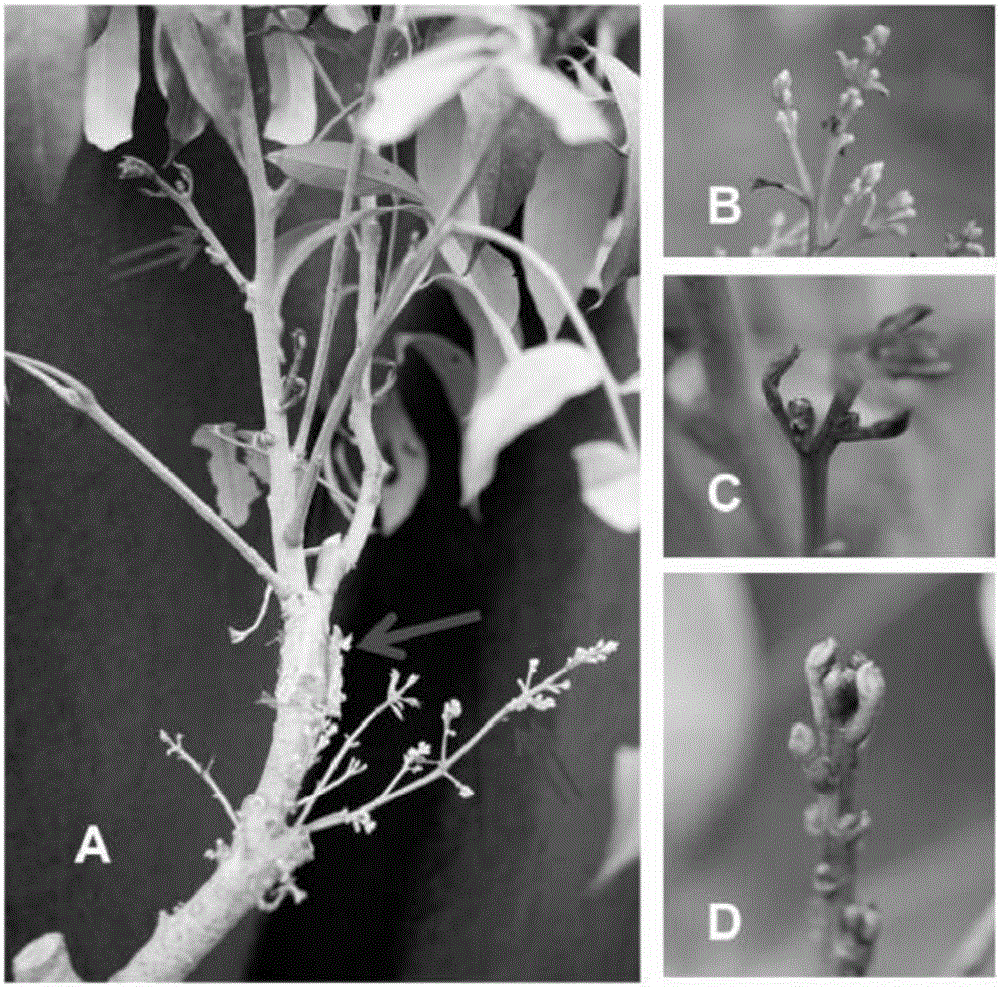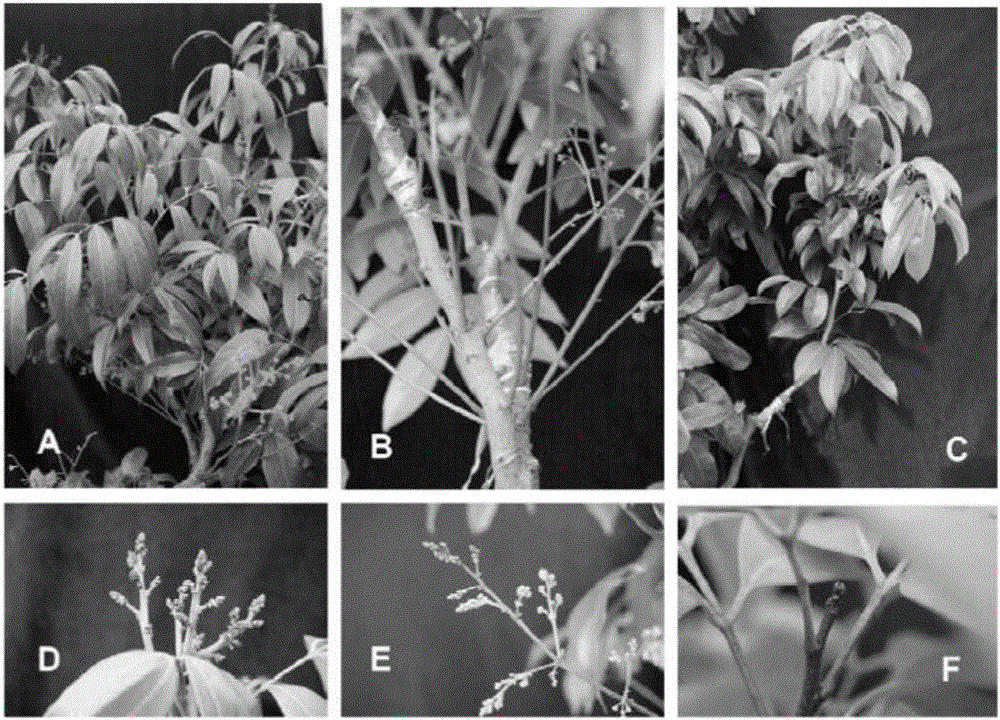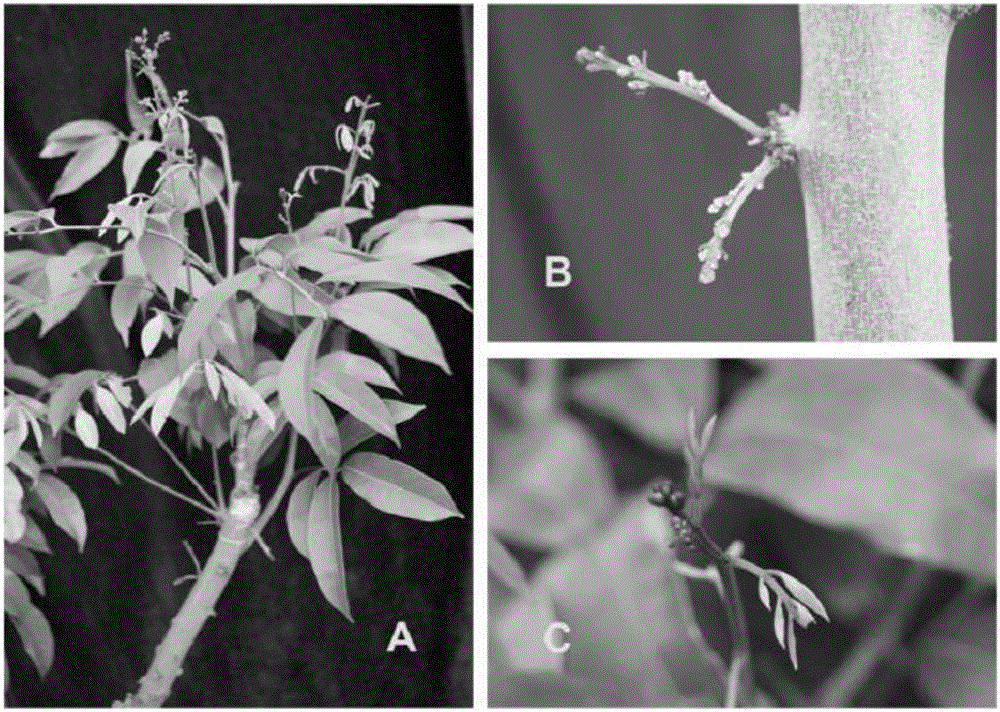Method for controlling late-maturing litchi to bloom earlier
A technology for early flowering and lychee, applied in the fields of botanical equipment and methods, horticulture, cultivation, etc.
- Summary
- Abstract
- Description
- Claims
- Application Information
AI Technical Summary
Problems solved by technology
Method used
Image
Examples
Embodiment 1
[0024] The circled 'Huaizhi' lychee seedlings were planted in 30-liter plastic pots with 1 part of peat soil, 2 parts of mushroom residue, and 3 parts of red loam soil. That is, grafting. The grafting was carried out on April 12, 2014. The branches were cut short to a thickness of 1.0 to 1.5 cm, and the '9918' lychee was grafted on it. and make up in time. After the grafting is completed, the scion at the upper end and the rootstock at the lower end are processed as follows respectively after the grafting:
[0025] The lower part of the graft joint: Periodically wipe off the buds that grow from the lower end of the graft joint until mid-September.
[0026] The upper part of the grafting interface: After the grafting survives, the upper part of the grafting interface (ie the scion) is pulled out of the tender shoots, and the leaves are sprayed with abamectin to control the new shoot pests such as leaf rollers, regularly apply compound fertilizers and trace elements, and culti...
Embodiment 2
[0029] The circled 'Huaizhi' lychees were planted in 30-liter plastic pots with 1 part of peat soil, 2 parts of mushroom residue, and 3 parts of red loam soil. Grafting was carried out on April 20, 2015. First, the branches were cut short to a thickness of 1.0 to 1.5 cm, and 'March Red' was grafted on it. The method was carried out by cutting and grafting. After 1 to 2 weeks of grafting, the survival was checked. rate, and make up for it in a timely manner. After the grafting is completed, the scion at the upper end and the rootstock at the lower end are processed as follows respectively after the grafting:
[0030] The lower part of the grafting interface: regularly erase the buds that grow from the lower end of the grafting interface (that is, the "Huaizhi" branch as the rootstock) until mid-September.
[0031] The upper part of the grafting interface: After the grafting survives, the upper part of the grafting interface (ie the scion) pulls out the tender shoots, sprays ab...
Embodiment 3
[0034] 'Huaizhi' ring branch seedlings were planted in 30-liter plastic pots with 1 part of peat soil, 2 parts of mushroom residue, and 3 parts of red loam soil. grafting. The grafting was carried out on April 20, 2014. The tip of the branch was cut short to a thickness of 1.0-1.5 cm, and the '9918' lychee was grafted on it, using the method of cutting and grafting. After grafting, new buds will grow at the lower end of the graft interface. Except for retaining one of the buds and letting it shoot out the shoots, the rest of the buds will be wiped off until mid-September. For the buds drawn from the scion on the upper part of the grafting mouth, spray Scherospen to control new shoot pests such as leaf rollers, protect the young shoots, cultivate two new shoots, and make the last shoots mature in early September. When the last shoots are mature, control the vegetative growth and regularly remove the tender shoots or buds on the last shoots. After a period of shoot control, in...
PUM
 Login to View More
Login to View More Abstract
Description
Claims
Application Information
 Login to View More
Login to View More - R&D
- Intellectual Property
- Life Sciences
- Materials
- Tech Scout
- Unparalleled Data Quality
- Higher Quality Content
- 60% Fewer Hallucinations
Browse by: Latest US Patents, China's latest patents, Technical Efficacy Thesaurus, Application Domain, Technology Topic, Popular Technical Reports.
© 2025 PatSnap. All rights reserved.Legal|Privacy policy|Modern Slavery Act Transparency Statement|Sitemap|About US| Contact US: help@patsnap.com



